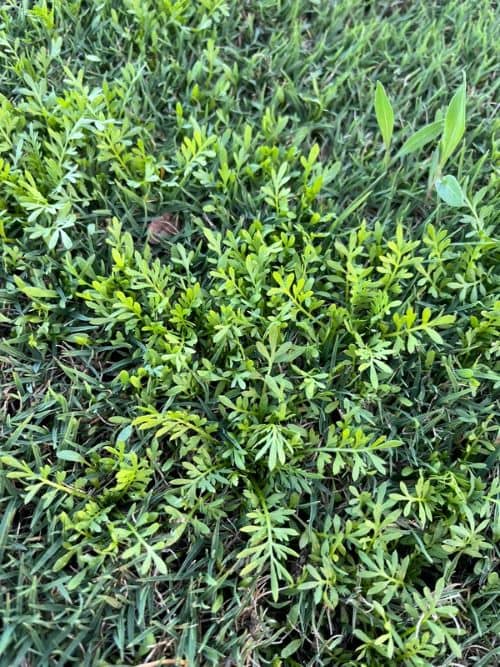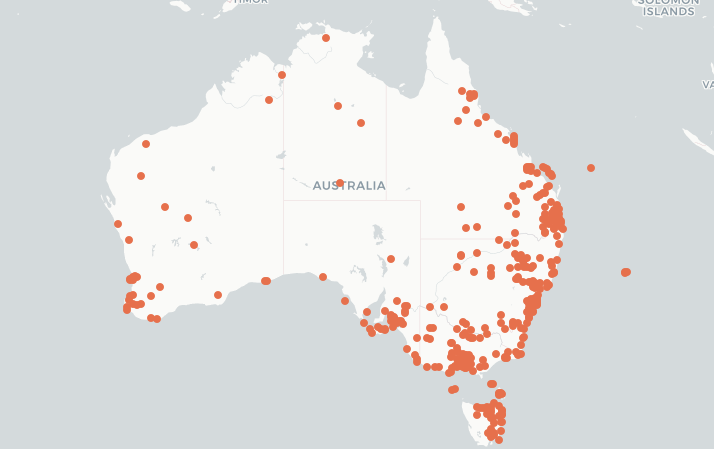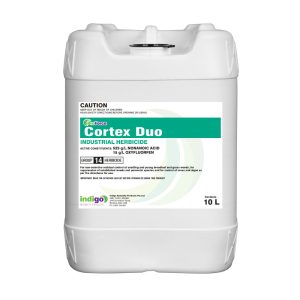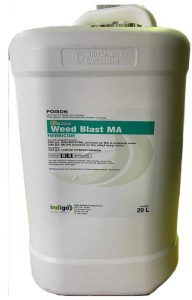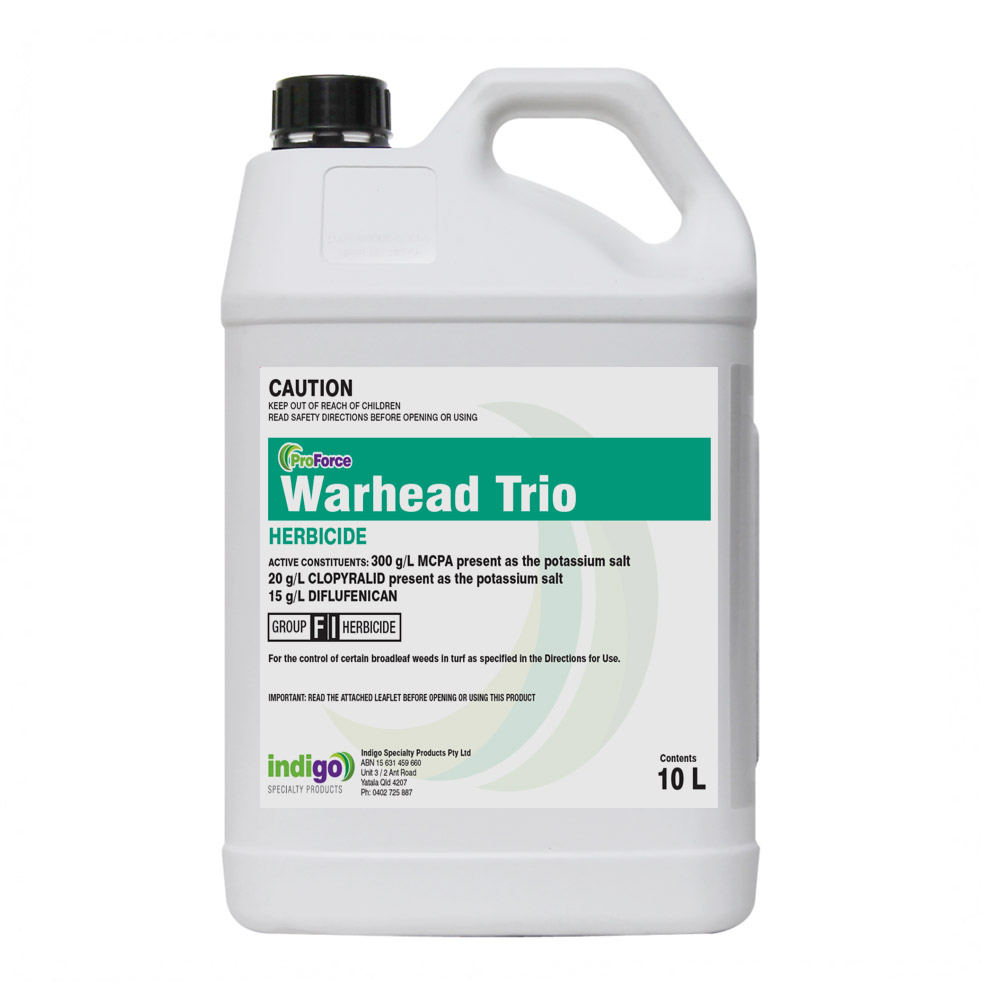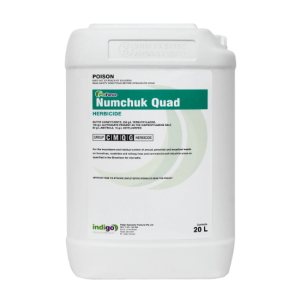Lesser Swinecress (Lepidium didymum)
Lesser Swinecress is known as Hogweed or Annual Ragweed, and is a spreading or semi-erect annual to perennial weed. It is a member of the Brassica family and so is in the same family as cabbage, kale, and broccoli.
After you read this, you will be able to:
- Identify Lesser Swinecress, Annual Ragweed or Hogweed.
- Know the habitat of Lesser Swinecress.
- Know the best cultural and chemical options to control Lesser Swinecress.
Why is Swinecress a Problem Weed?
- Swinecress tolerates heavy traffic, close mowing, and grows aggressively in turf areas with little competition.
- It causes major problems on dairy farms when eaten by lactating cows. The milk from these cows develops a distinctive taint, which is not wanted by milk processors.
The leaves of this plant are edible, and have a salty, cress or mustard flavour.
The distribution map for Lesser Swinecress is courtesy of The Atlas of Living Australia.
How to Identify Lesser Swinecress.
Swinecress, sometimes germinates in the Spring but mainly in the Autumn. It then grows rapidly, and forms a rosette that is up to 200 mm in diameter. As it matures the leaves become more lobed and then pinnate. Lesser Swincress has a distinctive foul cress smell when you crush it.
When young, Swinecress is easily confused with Bindii, and Common Cotula or Carrot weed.
Category: Broadleaf (Dicot).
Photosynthetic Pathway: Annual Ragweed is a C3 Weed.
Flower: Swinecress flowers from February through to October. It has tiny, white, four-petaled flowers on stalks that cluster along the flowering stem. These form a flower head that is about 1 to 4 cm long. The flowering stems mostly arise from where the leaf stalk meets the main stem.
Height: Young Swinecress plants are rosettes until they mature and a stem develops.
Lesser Swinecress grows in a prostrate fashion. The stems spread to almost 0.5 m along the ground but their tips tend to rise. The lower leaves grow on short stalks, whilst the upper leaves are stalkless and are alternate to one another on the stem.
Leaf length: The leaves of Annual Ragweed are deeply lobed, but are not fully divided into leaflets. They are about 1.5 to 7 cm long.
Leaf width: Swinecress leaves are hairy or hairless, and are 4 to 12 mm wide.
Reproduction: Lesser Swinecress spreads only by seed.
Comments: The leaves become more lobed and ultimately pinnate as the plant matures. As Swinecress matures, the prostrate stems form extensive mats on the ground. These look the same as Wireweed from a distance.
Habitat: You find Swinecress or Annual Ragweed in gardens, turf, along roadsides, and in disturbed areas. It tends to prefers higher rainfall areas.
For more information on weeds check out our weed ID Chart.
How to Control Lesser Swinecress.
You control Lesser Swinecress or Hogweed by cultural and chemical means, but successful management of this weed is best if you adopt an integrated approach.
Cultural Control of Swinecress:
- Lesser Swinecress doesn’t like competition so if you maintain a dense turf cover it prevents it from getting a toe-hold.
- Manual removal of Hogweed is effective but must be done at least every 8 to 10 weeks. Once the seed pods form, the seed often matures even if you uproot the plant. This means that you should aim to remove all Hogweed plants offsite that are in flower, rather than leave them on the ground. This ensures that no viable seed remains.
- Any soil disturbance often leads to a flush of Hogweed seedlings.
- Hogweed is tolerant of mowing in young lawns, but you can control it with selective turf herbicides.
Chemical Control of Lesser Swinecress.
The key to control Swinecress is to reduce the seedbank and keep it at a low level.
Pre-Emergent Control of Swinecress.
On this basis the pre-emergent herbicide BASF Freehand is worth looking at. This is registered to control Lepidium spp.
In the USA work shows that Isoxaben is especially good for to prevent Swinecress or Hogweed.
Table of Pre-emergent Herbicides for Swinecress in Turf.
Product | AI | FRAC Group | Rate per Ha | African Love grass | Annual Rye | Crabgrass | Creeping oxalis | Parramatta Grass | Paspalum | Summergrass | Winter Grass | Crowsfoot | White Clover | $ Cost / m2 | Longevity weeks |
Barricade | Prodiamine | 3 | 1 to 4 L | 143 to 572 | 24 | ||||||||||
Onset 10GR | Prodiamine | 3 | 50 to 150 Kg | 275 to 825 | 24 | ||||||||||
Echelon Duo | Oxadiazon | 14 | 300 to 400 Kg | 2100 to 2800 | 12 | ||||||||||
Dimension | Dithiopyr | 3 | 1.75 to 3.5L | 280 to 560 | 18 | ||||||||||
Freehand | Pendimethalin + dimethenamid-P | 3 + 15 | 100 Kg | 1585 | 12 | ||||||||||
Specticle | Indazaflam | 29 | 250 ml | 495 | 32 | ||||||||||
Pennmag | Metolachlor | 15 | 2 L | 45 | 8 |
Post Emergent Control of Swinecress.
Once it gets a bit larger, you need to use MCPA. However, even this doesn’t work well once Swinecress gets more mature, so it is best to treat it while it is young. Other options include 2,4-D and Dicamba.
Work in India has shown that Topremezone (BASF Pylex Herbicide) gives excellent post emergent control of Annual Ragweed in Chickpeas.
- 2,4-D. This tends to burn the top of White clover but it then grows back.
- MCPA.
- Warhead Trio. Safe on Buffalo grass.
- Contra M herbicide. Don’t use Contra M on Buffalo grass.
- Weed Blast MA. Safe on Buffalo grass.
- Dicamba. Don’t use Dicamba on Buffalo grass.
- Pylex Herbicide. Do not use on warm season turf.
- Stature. Stature Turf Herbicide is safe on all established cool and warm season grasses. Not for home garden use. A non-ionic surfactant is recommended.
Table of Post Emergent Swinecress Herbicides.
Product | Active | Chemical Group | Rate/Ha | Comments |
2,4-D | 2,4-D | 4 | 1.8-3.2L | Wet foliage. DO NOT mow lawn for 1 week before and at least 1 weed after use. DO NOT use on Buffalo grass (WA only). |
Contra M. | Dicamba + MCPA | 4 | 6.5 L | Apply in 250-400L water. DO NOT use on Buffalo grass. After use do not mow for 2 days before or after use or fertilize within two weeks. |
Dicamba 750 | Dicamba | 4 | 5.9 L/Ha Boom spray or 87ml per 15 L backpack | Use a minimum of 1000L/Ha water. Do not spray on Buffalo or Bent Grass. Add a surfactant and spray prior to flowering |
MCPA | MCPA | 4 | 930ml -1.8L | Apply in high volume to actively growing weeds. DO NOT mow for 2 days before use. Some transitory damage may occur to fine turf |
MetForce | Metsulfuron | 2 | 5 g/100 L or 7g/100 L if spraying rosette stage | Use an NIS wetter |
Pylex | Topramezone | 27 | 0.375 mL/ 100 m2 in 4-6 L water + 0.5% MSO | Apply to actively growing weeds. Two repeat applications 21-28 days apart are required for optimum control. You may see some minor transient bleaching of Bentgrass 7-14 days post use. For best results do not water or irrigate for 24 hrs post use. |
Warhead | MCPA + Clopyralid + Diflufenican | 4 + 12 | 5 L | You may see discolouration on kikuyu, carpet grass and Queensland blue. Avoid overlapping. Use an NIS. |
Weed Blast MA. | Bromoxynil + MCPA | 6 + 4 | 3-6 L | Apply in a minimum of 500L/Ha water. DO NOT mow for 2 days after use. |
Non Selective Control of Swinecress.
- Glufosinate-ammonium provides control for 4 to 6 weeks, but it regrows and recovers due to the limited movement of glufosinate.
- Glyphosate. You can use Glyphosate but if you use Glyphosate, and water quality is an issue then use ProForce Manta Ray.
The following are non-selective but also have a long term residual and stop re-growth of Swinecress.
- Renegade. Renegade stops germination for up to 12 months, and reduces the need for multiple herbicide applications.
- Numchuk Quad. This gives effective post and pre emergent Hogweed control for up to 12 months.
- Cortex Duo. Cortex Duo gives a rapid knockdown of Swinecress, and residual control for up to 3 months. It is also safe to use around trees.
Table of Non Selective Herbicides for Swinecress.
Product | Active Ingredient | Group | Use Rate/Ha |
Glufosinate 200 | Glufosinate-ammonium | 10 | 1 to 6 L |
Rapid Fire 800 | Glyphosate | 9 | 0.9 to 1.35 Kg |
Numchuk Quad | Terbuthylazine + Glyphosate + Amitrole Oxyfluorfen | 5 + 9 + 34 + 14 | 20 to 25 L |
Cortex Duo | Nonanoic Acid + Oxyfluorfen | 14 | 7 L/1000L |
Renegade | Bromacil | 5 | 3.5 to 6.5 Kg |

